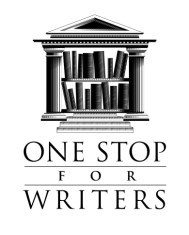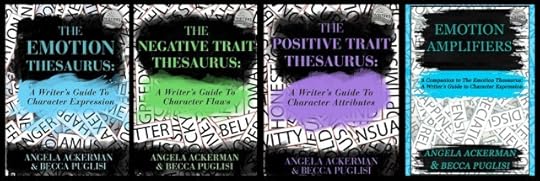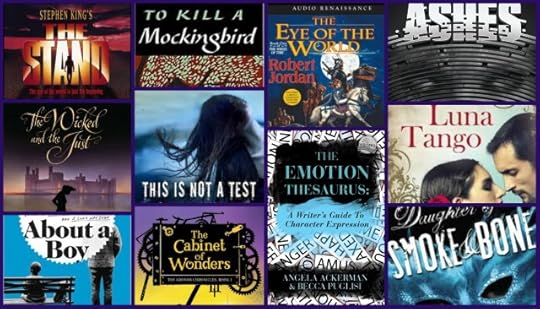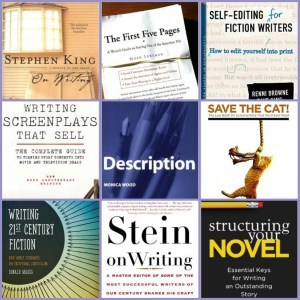Angela Ackerman's Blog: Writers Helping Writers, page 139
January 14, 2016
The Emotion Thesaurus Celebrates 1000 Amazon Reviews
![Pageflex Persona [document: PRS0000046_00058]](https://i.gr-assets.com/images/S/compressed.photo.goodreads.com/hostedimages/1444438238i/16500206.jpg) Wow, 1000 reviews. It’s incredible to think that our unusual little book on emotions would win the hearts of so many people. Heartfelt thanks go out to each one of you who took the time to review us on Amazon, on Goodreads, at Barnes & Noble, Kobo, and other e-tailers.
Wow, 1000 reviews. It’s incredible to think that our unusual little book on emotions would win the hearts of so many people. Heartfelt thanks go out to each one of you who took the time to review us on Amazon, on Goodreads, at Barnes & Noble, Kobo, and other e-tailers.
You might not realize it, but each one of these reviews is incredibly important.
As writers, we all understand an idea can’t be copyrighted. That’s how it goes. And while in fiction the same idea can yield vastly different stories, this is not always the case when it comes to nonfiction.
When Becca and I first started writing these thesaurus books, there wasn’t much out there that we could compare ourselves to because our list format made our descriptive resource somewhat of a hybrid: part tool, part book.
Now? There’s quite a few description-focused writing books using lists (some similar to our topics here at WHW). And if you ran a search for titles, well, let’s just say you’d find more than a few with the word “Thesaurus” in them.
This brings us back to the huge role reviews play and why we cherish each one so much.
With each review, you’re helping our Writers Helping Writers brand of thesaurus books stand apart from all others.
 So THANK YOU. Becca and I are so lucky to have such great readers! Your incredible love and support is what drives us to create books that help writers in the ways they need most.
So THANK YOU. Becca and I are so lucky to have such great readers! Your incredible love and support is what drives us to create books that help writers in the ways they need most.
To celebrate this awesome milestone, we have a fun giveaway for you! Your reviews and recommendations helped us get to 1000 on Amazon, so we’re spreading the book love. Here are some of our favorite ebooks, all up for grabs:
Becca’s Favorite Stephen King book: The Stand (Survival/Horror)
Angela’s Most Dog-Eared Book: The Eye Of The World (Robert Jordan – Epic Fantasy)
Becca’s Favorite Banned Book: To Kill a Mockingbird (Harper Lee – Drama)
Angela’s Favorite Australian Author Read: Midnight Serenade “Luna Tango” (Alli Sinclair – Romance)
A Book That Made Becca Laugh Out Loud: About a Boy (Nick Hornsby – Contemporary)
A Children’s Book Angela Wishes She’d Written: The Cabinet of Wonders (Marie Rutkoski – Middle Grade Fantasy)
Becca’s Favorite Zombie Book: Ashes (Ilsa J. Bick – Dystopian)
Angela’s Favorite End Of The World YA: This Is Not A Test (Courtney Summers – Horror/Survival)
Stand-alone Book That Becca Wishes Had a Sequel: The Wicked and the Just (Anderson J Coats – Historical YA)
A Book That Gripped Angela & Becca From First Page To Last: Daughter of Smoke and Bone (Laini Taylor – Fantasy)
And it wouldn’t be right to not give away a few Emotion Thesaurus Books, right? So in addition to the above, we’ll also give away 3 ebooks of the ET.
 *Want to win one of these terrific e-reads?
*Want to win one of these terrific e-reads?Just comment with your top 4 choices. We’ll use our friend Random.org to select winners. Contest closes midnight EST Friday January 15th, and winners will be announced Saturday, January 16th. As always, social sharing is appreciated but never a requirement to enter.
*Must be 18, no purchase necessary, open to all unless prohibited by law. For the full legal rules and disclaimers, go here.
What’s your favorite book in one of our categories? Let us know so we can check it out!
Happy reading, and good luck!
~ A & B
The post The Emotion Thesaurus Celebrates 1000 Amazon Reviews appeared first on WRITERS HELPING WRITERS™.
January 12, 2016
How (and Why) to Write a Logline For Your Story
 I’ve been thinking recently about loglines (I’ll tell you why in a bit) and why every author should have one for his/her story. We haven’t talked much about this at the blog, so I wanted to briefly discuss what a logline is and why you should have one.
I’ve been thinking recently about loglines (I’ll tell you why in a bit) and why every author should have one for his/her story. We haven’t talked much about this at the blog, so I wanted to briefly discuss what a logline is and why you should have one.
What is a logline?
A logline is a one- or two-sentence pitch that explains what your story is about in a way that makes listeners want to read it. Loglines are important because people will always be asking you: What’s your book about? Sometimes, those people will be influential folks, like editors, agents, publishers, etc. Sometimes they’ll be other important people, like potential readers who might buy your book if it catches their fancy. The tricky thing is…this question is usually an impromptu one. It comes up unexpectedly, and if you’re not prepared, it can catch you off guard. So it’s always good to have a logline prepared.
Another good reason to write a logline is because it defines your story. If you can’t write a good one, it may not be the logline that’s the problem, but your story itself. Writing a logline can help you see potential problems or gaps within your story that will need addressing in order to get you back on the right track.
Here are a few examples of loglines from movies you might recognize (and they’ll also hint at how old I am):
A small time boxer gets a once in a lifetime chance to fight the heavyweight champ in a bout in which he strives to go the distance for his self-respect. (Rocky)
A young man is accidentally sent 30 years into the past in a time-traveling DeLorean invented by his friend, Dr. Emmett Brown, and must make sure his high-school-age parents unite in order to save his own existence. (Back to the Future)
When a gigantic great white shark begins to menace the small island community of Amity, a police chief, a marine scientist, and a grizzled fisherman set out to stop it. (Jaws)
What should a logline include?
Each of these loglines contain three things: the protagonist, the overall goal, and the stakes. Let’s look at them again to see the breakdown:
A small time boxer (protagonist) gets a once in a lifetime chance to fight the heavyweight champ in a bout in which he strives to go the distance (goal) for his self-respect (stakes).
A young man (protagonist) is accidentally sent 30 years into the past in a time-traveling DeLorean invented by his friend, Dr. Emmett Brown, and must make sure his high-school-age parents unite (goal) in order to save his own existence (stakes).
When a gigantic great white shark begins to menace the small island community of Amity (stakes), a police chief (protagonist), a marine scientist and a grizzled fisherman set out to stop it (goal). In this example, the stakes are implied rather than stated outright, but mentioning that a gigantic shark is menacing a small island is enough to show what’s at stake.
It’s important to be able to narrow your story down to these three elements. It’s also important to phrase them in a way that creates interest and intrigue. If you can accomplish this, you’ll have created an honest and catchy pitch to give to anyone who might be interested in your story. And that could pay off in book sales, manuscript requests, and editor/agent interest.
Another way it could pay off is with this month’s Critiques 4 U contest :). Instead of randomly choosing winners like I usually do, I’m switching thing up and am going to choose based on your loglines. The ones that include the three required elements and intrigue me the most are the ones that will win a first-page critique. I know I’m asking for more this time, because instead of simply entering, you’ll have to do some work in advance to prepare your logline. For this reason, I’ll be leaving the contest open for two days instead of the usual one, to give you some prep time. And to sweeten the pot, the three winners will ALSO win a one-month subscription to One Stop For Writers.
So get to work on those log lines and come bacon the 19th, when the contest begins. Winners will receive a critique and the gift of One Stop; and those of you who don’t win will have created a tool that can be used to pitch your story to anyone who’s interested.
Best of luck!
Before You Go…
Angela is posting over at TheWriteChris today. So, if you’d like to catch her 3 Brainstorming Tips for Writing Fresh Body Language To Describe Character Emotion, stop on by!
The post How (and Why) to Write a Logline For Your Story appeared first on WRITERS HELPING WRITERS™.
January 9, 2016
Emotional Wound: Finding Out One Is Adopted
When you’re writing a character, it’s important to know why she is the way she is. Knowing her backstory is important to achieving this end, and one of the most impactful pieces of a character’s backstory is her emotional wound. This negative experience from the past is so intense that a character will go to great lengths to avoid experiencing that kind of pain and negative emotion again. As a result, certain behaviors, beliefs, and character traits will emerge.
 Characters, like real people, are unique, and will respond to wounding events differently. The vast array of possible emotional wounds combined with each character’s personality gives you many options in terms of how your character will turn out. With the right amount of exploration, you should be able to come up with a character whose past appropriately affects her present, resulting in a realistic character that will ring true with readers. Understanding what wounds a protagonist bears will also help you plot out her arc, creating a compelling journey of change that will satisfy readers.
Characters, like real people, are unique, and will respond to wounding events differently. The vast array of possible emotional wounds combined with each character’s personality gives you many options in terms of how your character will turn out. With the right amount of exploration, you should be able to come up with a character whose past appropriately affects her present, resulting in a realistic character that will ring true with readers. Understanding what wounds a protagonist bears will also help you plot out her arc, creating a compelling journey of change that will satisfy readers.
FINDING OUT ONE IS ADOPTED
NOTE: We realize that sometimes a wound we profile may have personal meaning, stirring up the past for some of our readers. It is not our intent to create emotional turmoil. Please know that we research each wounding topic carefully to treat it with the utmost respect.
Examples: being told by one’s parents once reaching a certain age, discovering by accident (overhearing a conversation, finding one’s birth certificate, being contacted by a birth parent or sibling, etc.), finding out because of an illness that requires knowing one’s medical history, confronting one’s parents because one does not look like one’s family, finding out after the death of one’s parents
Basic Needs Often Compromised By This Wound: safety and security, love and belonging, esteem and recognition, self-actualization
False Beliefs That May Be Embraced As a Result of This Wound:
I’m obviously defective, or why else would my real parents give me up?
Everything I know is a lie; after all if my parents lied about this, what else is untrue?
I don’t belong anywhere; no one wants me
I probably should never have been born
I don’t know who I am
I can’t trust anyone
Anyone I get close to will sense there’s something different about me
If I get into a serious relationship, I’ll only be abandoned
I can’t show my true feelings to anyone
Positive Attributes That May Result: adaptable, analytical, appreciative, centered, diplomatic, empathetic, happy, honest, introverted, mature, kind, loyal, philosophical, private, sentimental, supportive, wise
Negative Traits That May Result: abrasive, addictive, confrontational, cynical, defensive, disrespectful, gullible, hostile, manipulative, materialistic, needy, oversensitive, pessimistic, rebellious, resentful, self-destructive, suspicious, uncommunicative, ungrateful, withdrawn, workaholic
Resulting Fears:
Fear of abandonment
Fear of trusting the wrong person
Fear of vulnerability
Fear of meeting one’s birth family and being rejected a second time
Fear of being loved less than one’s siblings
Fear of rejection
Fear of relationships
Possible Habits That May Emerge:
mood swings (anger, betrayal, gratitude, mistrust, guilt, confusion)
examining all of one’s relationships with family, searching for indications that one is being treated differently or loved “less”
refusing to seek out one’s roots or past, living in denial
growing obsessive about one’s past; asking constant questions, needing to know one’s roots
difficulty trusting people
over-concentrating on the differences between oneself and one’s adopted family
having a hard time saying goodbye or letting people go
going out of one’s way to prove one’s worth to friends (worrying about being abandoned by them)
questioning what people say without cause, looking for or expecting deceit
pulling back from adopted family members, becoming uncommunicative and isolated
angry outbursts; a short temper
medicating through alcohol
experiencing anxiety or situational depression
double checking facts rather than taking someone at their word
developing insecurities about one’s performance at work or school
feeling relieved as one has felt on some level that one was different, then feeling guilty for the relief
rejecting adoptive family mementos or heirlooms, feeling unworthy of them
refusing to tell even a white lie
Having a negative outlook; cynicism
TIP: If you need help understanding the impact of these factors, please read our introductory post on the Emotional Wound Thesaurus. For our current list of Emotional Wound Entries, go here.
For other Descriptive Thesaurus Collections, go here.
Image: thetruthpreneur @ Pixabay
The post Emotional Wound: Finding Out One Is Adopted appeared first on WRITERS HELPING WRITERS™.
January 6, 2016
Mastering the Art of the Cliffhanger Chapter Ending
People are always talking about how important it is to keep the reader interested. Retain their interest. Keep them turning pages all the way until the end. One way to do this, I keep hearing, is though the cliffhanger chapter ending. But no one ever tells you HOW to write the cliffhanger effectively. My biggest question: If you don’t end your chapter at the end of your scene, how DO you end your scene?
Well, I’m happy to welcome Rebecca Belliston, who’s here to answer that question and offer some advice on how to write cliffhanger endings well.

Courtesy: Morguefile.com
One of the best things an author can hear from a reader is, “I’m so exhausted. I stayed up until four in the morning to finish your book.” And then they go on to complain about how they’re going to fall asleep in class or at an important meeting.
When this happens to me, I swallow a grin and say, “Oh, I’m sorry I kept you up so late.” But really, I’m not sorry. Not at all. Because if they were willing to give up sleep, they must have really liked the book.
The Importance of Chapter Endings
Often writers are told to work on the hook of their story, making readers interested in the characters and setting within the first page or two. And while that’s important (and extremely daunting), it’s equally important to keep the reader reading all the way until THE END. Because, let’s face it. We’ve all started books we’ve never finished. Heaven forbid our readers do that with our masterpieces, right?
But I’ve found that the following formula works pretty well to keep readers reading:
End chapters with a cliffhanger as often as possible.
Think about TV shows, especially dramas. They cut to commercial at the height of the scene’s intensity, not at its resolution. Even in reality shows, the music builds to a dramatic swell and then, BAM! You’re watching a Geico commercial. They do that so you don’t leave. So you don’t get distracted grabbing Oreos and a glass of milk during those two minutes and forget to come back.
But as authors, we’re tempted to stop chapters when the conversation winds down or the conflict is resolved—basically, at the end of the scene. It’s a natural break in the story, so it seems like a sensible place to end the chapter. However, if we end every chapter with a resolved scene, readers might leave for those Oreos and find something else to do. When it comes to holding reader interest, knowing when to end a chapter matters almost as much as knowing what content to include within the chapter.
Suzanne Collins did an amazing job of this in the Hunger Games. Chapter after chapter, she left us hanging:
“Effie Trinket crosses back to the podium, smoothes the slip of paper, and reads out the name in a clear voice. And it’s not me.
It’s Primrose Everdeen.”
I’ll tell you, that one grabbed my attention. So did this one:
“For a moment, everything seems frozen in time. Then the apples spill to the ground and I’m blown backward into the air.”
Now, would you stop there to go get a treat? To sleep? No way. You’d fly through the pages, hardly even noticing the chapter breaks because the story was flowing so seamlessly.
So How Do You End Scenes Without Using Chapter Breaks?
1) End the scene in the middle of a chapter. Then, a few pages or paragraphs later, when your scene does end, just use the classic three-star break to show that a new scene is beginning:
***
For example, end the chapter with Humpty Dumpty in the act of falling off the wall, so the reader has to start a new chapter to find out what happens. The next chapter begins with him broken on the ground, helpless. A little later in the chapter, when you need to end the scene and switch to the POV of the kings’ men, do a little *** to make the jump.
Readers are less likely to put down a book after this kind of break because it’s softer than a chapter break. They also don’t have to physically turn the page to move on to the next scene; the rest of the text is right there on the same page, enticing them to continue reading.
2) Use a simple transition sentence to change scenes.
Since the Hunger Games often ended chapters with cliffhangers, many of the scenes themselves ended in the middle of the chapter. To make this work, Suzanne Collins used one or two transitional sentences to indicate a scene break. She even skipped days with a simple transition sentence like this one: “Even two days later, Katniss still couldn’t…”
(NOTE: This only works if you aren’t jumping POVs. If you’re changing the POV, you must use a chapter break or a *** to show the change.)
3) If you do need to end a scene at the end of the chapter, leave something unresolved— something in the air that’s big enough to make the reader turn the page. Chances are that if you’re aware that you need to leave something hanging, you’ve found a possible spot to end the scene.
Use these techniques and you’ll greatly reduce the number of bookmark-able places in your story. Watch TV shows and read books to see how it’s done. The more you practice writing chapter and scene endings this way, the more natural it will feel to leave your readers hanging and begging for more.
 Rebecca Lund Belliston is the bestselling author of the Citizens of Logan Pond dystopian trilogy and the LDS romantic suspense novels, Sadie and Augustina. She’s a sucker for a good romance, a good clean romance, and as such she layers her stories with page-turning romance and heart-pounding adventure. She’s also the bestselling composer of religious and classical-style music that has been performed around the world.
Rebecca Lund Belliston is the bestselling author of the Citizens of Logan Pond dystopian trilogy and the LDS romantic suspense novels, Sadie and Augustina. She’s a sucker for a good romance, a good clean romance, and as such she layers her stories with page-turning romance and heart-pounding adventure. She’s also the bestselling composer of religious and classical-style music that has been performed around the world.
When she’s not writing fiction or music or chasing her kids, she loves to cuddle up with a good book. She and her husband live in beautiful Michigan with their five kids. Connect with her on Twitter and discover her books here.
The post Mastering the Art of the Cliffhanger Chapter Ending appeared first on WRITERS HELPING WRITERS™.
January 4, 2016
Is 2016 Your Year? Make A Writing Plan And Take Out The Guesswork
Becca and I love you guys. We want to see you break barriers, build careers, and enjoy success after writing success. Supporting you is what we’re about and what we do. We enjoy helping however possible, encouraging each of you to grow and be awesome as only you can.
 To do this well, sometimes we have to nudge. Push a little, even. But our hearts are in the right place, because there’s no point candy coating the work it takes to be a successful writer. It will require every drop of strength and persistence you have to keep moving forward in the face of obstacles, rejection and doubt. You will have to grow thick skin, thicker than you ever thought possible. You will have to wear the hat of a learner, because you will never know it all or reach a point of ‘good enough’ when it comes to writing. There will always be more craft to absorb, more skills to hone, more marketing and business challenges to overcome, more work needed to expand your career, year after year.
To do this well, sometimes we have to nudge. Push a little, even. But our hearts are in the right place, because there’s no point candy coating the work it takes to be a successful writer. It will require every drop of strength and persistence you have to keep moving forward in the face of obstacles, rejection and doubt. You will have to grow thick skin, thicker than you ever thought possible. You will have to wear the hat of a learner, because you will never know it all or reach a point of ‘good enough’ when it comes to writing. There will always be more craft to absorb, more skills to hone, more marketing and business challenges to overcome, more work needed to expand your career, year after year.
So in our tough-love yet encouraging fashion, Becca and I are starting the year with a challenge for you: steer your own ship. Make a plan. Treat your writing like the business it is.
And this isn’t hot air, I promise–we live what we preach. Since organizing ourselves and adopting a yearly business plan in 2012, we have accelerated our careers. Not only have we built multiple businesses, published books in 5 languages, created a one-of-a-kind writing library and grown Writers Helping Writers into a learning hub with a loyal following, we teach and speak professionally as writing coaches. It didn’t happen overnight, and it didn’t happen easily, but it happened.
And guess what? Neither one of us is special. We don’t have a magic 8-ball, or pet hamsters that shoot lasers out of their eyes while predicting the future. We’re just Angela and Becca, two writers who met in an online critique group.
What’s I’m saying is…if we can do this, you can too. So let’s get started.

Organize The Chaos
Most say writers write, but I think writers actually juggle. Yes, they do write, edit, and learn. But they also research the industry and their audience, build a brand, create a platform, handle marketing, promote, and run a business. And that, my friend, is juggling.
Trying to master all these aspects of a writing career is chaotic. There are countless books and articles to read on various subjects of writing, publishing and marketing, experts to heed, social media platforms to navigate, people to connect to and opportunities to take advantage of. And often what happens is the writer is pulled into so many directions at once, no real headway is made on bigger goals. Instead writing time is spent on a million mini tasks that seem valid at the time, but may not be.
 In 2012, Becca and I found our time was being eaten by all the little things that come with running a larger site like Writers Helping Writers. Our days were spent neck deep in email, social networking, blog comments, and guest posting. And guess what wasn’t getting done? Writing. And well, that’s sort of the point, wouldn’t you say?
In 2012, Becca and I found our time was being eaten by all the little things that come with running a larger site like Writers Helping Writers. Our days were spent neck deep in email, social networking, blog comments, and guest posting. And guess what wasn’t getting done? Writing. And well, that’s sort of the point, wouldn’t you say?
We knew we needed to organize ourselves and prioritize better. We wanted a way to measure each opportunity that came our way and make better decisions with our time. Luckily, my husband is a business management consultant, and he led us through the process of creating a business plan. The start was to assess where we were at, and define where we still needed to grow.
Ask Yourself The Tough Questions
In the business world, assessments are common. People are brought in to examine departments and processes, do risk assessments, and conduct 360° reviews on employees. A company needs to be efficient and functional to prosper, and a writer’s career is no different. So take a step back and look at where you are at. What areas did you focus on this past year, and what was your progress toward big goals? If you could do it all over, would you do it the same way, or organize your time differently?
Taking stock of where you are, and where you want to go is a great way to hone in on what to focus on in the coming year. If you can be honest about areas you are weaker in and what you must strengthen to position yourself better, you’ll save yourself heartache. For example, if your writing is really strong, you have a book you feel is marketable but you have no online presence whatsoever, spending more energy honing your craft isn’t the best use of your time. Instead, you might want to make getting yourself online, learning how to network and find ways to build relationships with your potential audience a primary focus. Yes, this might seem scary, but pushing out of your comfort zone will help you grow.
Likewise, if you are a Social Media queen but your writing skills are less-than-adequate, start boning up on your writing craft. Read, take classes and practice technique. A great platform will not sell a poorly written book.
Be a Planner, Not a Pantser
 Lots of writers like to “pants” it. A little, a lot, maybe the whole book is written on the fly, a joy ride from start to finish. What will the main character do? Where will he go? How will the book end? Who knows—that’s all part of the fun.
Lots of writers like to “pants” it. A little, a lot, maybe the whole book is written on the fly, a joy ride from start to finish. What will the main character do? Where will he go? How will the book end? Who knows—that’s all part of the fun.
And pantsing might work great…in fiction. But in business, pantsing will hurt you, or perhaps better said, will hurt your potential. Because while you’re flying along, researching weather patterns for a new story idea you have here, increasing your twitter following there, and flirting with a group promotion or two when invites roll in…you are missing the forest for the trees. Rather than take confident strides toward achieving specific goals to help you leap forward, you’re taking half-steps in too many directions and hardly getting anywhere.
Like Becca and I did, you might need some structure. A road map, a way to determine what areas are the most important to work on, what goals should be the focus, and the timeline needed for each. You won’t believe how well this will help keep you on track, and just how much more you’ll get done in a year.
 I realize for many, the words, “business plan” probably sounds intimidating, but it really is so simple—7 steps will get you there. In fact, I wrote a post about the process at Jane Friedman’s blog, so please, check it out. Everything you need is there—the steps, a template, and even an example of one of our old business plans. (Take advantage of some free professional business consulting!)
I realize for many, the words, “business plan” probably sounds intimidating, but it really is so simple—7 steps will get you there. In fact, I wrote a post about the process at Jane Friedman’s blog, so please, check it out. Everything you need is there—the steps, a template, and even an example of one of our old business plans. (Take advantage of some free professional business consulting!)
You love what you do, and you work hard every day, I know it. You are capable of so much, so challenge yourself! Make 2016 your year.
Happy writing and business-planning,
Angela
Image1: geralt @ Pixabay
Image2:McLac2000 @ Pixabay
Image3: JosephKah @pixabay
Image4: Alexas_fotos@pixabay
The post Is 2016 Your Year? Make A Writing Plan And Take Out The Guesswork appeared first on WRITERS HELPING WRITERS™.
December 23, 2015
Warm Holiday Wishes
 The time has arrived for Becca and me to sweep up, lower the lights and lock up until the New Year. We sincerely hope that you have a wonderful holiday season with your loved ones and friends. So, get some reading in, play a board game or two, watch a few movies and fill your creative wells.
The time has arrived for Becca and me to sweep up, lower the lights and lock up until the New Year. We sincerely hope that you have a wonderful holiday season with your loved ones and friends. So, get some reading in, play a board game or two, watch a few movies and fill your creative wells.
And, if you are looking to beef up your craft, here are some of the most popular writing articles this year at Writers Helping Writers:
The Four Types of Character Flaws
Planning A Novel: Character Arc In A Nutshell
Character Descriptions: Learn From The Pros
5 Important Ways To Use Symbolism in Your Story
Understanding Character Wounds: A List Of Common Themes
Hidden Emotions: How To Tell What Characters Don’t Want To Show
See you in 2016!
~ Angela & Becca
Image: AgnesR @ PIxabay
The post Warm Holiday Wishes appeared first on WRITERS HELPING WRITERS™.
December 21, 2015
Boost Your Writing: 3 Things To Do Now To Start 2016 Off Right
With Christmas right around the corner, it can be hard to think about getting organized for a new year of writing, but trust me, this is exactly what we should do. Why? Because when the calendar flips, life resets in our heads. Determined and full of fire, we set out to make 2016 our year.
But this energy peters out pretty quick if we get bogged down in all the little housekeeping things that nibble our time. So, use this lead up to January wisely and knock a few important tasks off the ‘ol list so 2016 starts with a bang.
Housekeeping Task #1:
Back up your work.
 I know, it’s obvious. And yet…do you? I mean we all know the danger of not backing up work, but let’s face it, computer crashes happen to OTHER people, right? Um, no. It can and probably WILL happen to you at some point. So, yep, back your work up. Now’s the perfect time to do it!
I know, it’s obvious. And yet…do you? I mean we all know the danger of not backing up work, but let’s face it, computer crashes happen to OTHER people, right? Um, no. It can and probably WILL happen to you at some point. So, yep, back your work up. Now’s the perfect time to do it!
Housekeeping Task #2:
Do some weeding.
Weeding? Um, Angela…it’s December. The only weeds outside are curled up in their death throes under the snow.
 Bear with me…I promise it isn’t the eggnog talking. The overgrown gardens we need to turn our attention to are the word files on our computers.
Bear with me…I promise it isn’t the eggnog talking. The overgrown gardens we need to turn our attention to are the word files on our computers.
Think about it…just how many versions of the same story do you have on your computer? How many blog posts, revisions of query letters, pitches, story notes, character profiles and worksheets…well, you get the idea.
Over the years, this stuff piles up. It becomes a mountain of data. The truth is, we can’t bear to let any of it go, these words of ours. We’re so sure that at some point, we’ll want that 7th revision of chapter 9, absolutely. And even if we finish the novel and move on to another, dang it, maybe that discarded paragraph 3 in that first draft can be used in a new story!
Group therapy time: we need to let some of these old files go. Once we’ve finished revisions on a book, there’s really no reason to keep all the old bits and bobs. So take a look at the scary patch of files and ask yourself, do I really need this? If you truly don’t, give yourself a Christmas gift and purge.
Housekeeping Task #3:
Okay, up until now, we’ve taken some baby steps. You’ve done well. In fact, you’re a freaking rock star. But now…we need to talk about the biggie. I know, you don’t want me to go there, but I have to. It’s the Thing That Must Not Be Named.
Your desk. Your workpace.
 Yes, I know your dirty little secret…those drawers are an episode of Hoarders. Maybe several episodes. You think my desk looks any different? It doesn’t.
Yes, I know your dirty little secret…those drawers are an episode of Hoarders. Maybe several episodes. You think my desk looks any different? It doesn’t.
Here’s the deal: if we really want to give ourselves a clear mind in January, we need to clean our surroundings. Make our fresh start a TRUE fresh start.
If your desk is a mess, your drawers are filled with God-knows-what, and there’s so much of it you haven’t seen the bottom in a good year or two, it’s time to excavate.
Trust me, you will feel so much better knowing those drawers actually shut like they are supposed to. And it probably won’t kill you to dust. Or empty the trash. So sort, organize and recycle!
 And here’s a bonus tip for making 2016 your year…join hundreds of your fellow writers over at One Stop For Writers. The One Stop library is the result of writing passion. Becca, Lee & I created it to help you elevate your writing, and to assist through tools, resources and descriptive inspiration so that you spend less time searching for the right words and more time actually writing them.
And here’s a bonus tip for making 2016 your year…join hundreds of your fellow writers over at One Stop For Writers. The One Stop library is the result of writing passion. Becca, Lee & I created it to help you elevate your writing, and to assist through tools, resources and descriptive inspiration so that you spend less time searching for the right words and more time actually writing them.
Registration is always free, because we want you to see what we’re all about, no risk. So stop in and check us out. If you like what you see, why not ask Santa for a Gift Certificate? For the price of two coffees a month, you can move into 2016 knowing you’re doing something huge to give your writing career a boost.
 FACT: a bit of housekeeping means closing out 2015 like a CHAMP.
FACT: a bit of housekeeping means closing out 2015 like a CHAMP. And we both know that your rock star attitude toward organizing and growing your writing craft means 2016 is going to be GREAT.
Happy writing & organizing!
~Angela
Image 1: HerbieFot @ Pixabay
Image 2: Elizabethmh @ Pixabay
Image 3: Nathan Copely @ Pixabay
Image 5: PubiKado @ pixabay
The post Boost Your Writing: 3 Things To Do Now To Start 2016 Off Right appeared first on WRITERS HELPING WRITERS™.
December 19, 2015
Emotional Wound Thesaurus Entry: Experiencing a Miscarriage or Stillbirth
When you’re writing a character, it’s important to know why she is the way she is. Knowing her backstory is important to achieving this end, and one of the most impactful pieces of a character’s backstory is her emotional wound. This negative experience from the past is so intense that a character will go to great lengths to avoid experiencing that kind of pain and negative emotion again. As a result, certain behaviors, beliefs, and character traits will emerge.
Characters, like real people, are unique, and will respond to wounding events differently. The vast array of possible emotional wounds combined with each character’s personality gives you many options in terms of how your character will turn out. With the right amount of exploration, you should be able to come up with a character whose past appropriately affects her present, resulting in a realistic character that will ring true with readers. Understanding what wounds a protagonist bears will also help you plot out her arc, creating a compelling journey of change that will satisfy readers.
NOTE: We realize that sometimes a wound we profile may have personal meaning, stirring up the past for some of our readers. It is not our intent to create emotional turmoil. Please know that we research each wounding topic carefully to treat it with the utmost respect.

The rows of Jizo stone statues represent the unborn children of Japan. Grieving parents place toys and other offerings beside the Jizo statue to invoke his protection of their miscarried children.
While women bear both the emotional and physical strains of a miscarriage or stillbirth, men can suffer just as much emotionally from this kind of loss. Depending on a number of factors, this tragedy could be a wounding event for either parent.
Basic Needs Often Compromised By This Wound: safety and security, esteem and recognition, self-actualization
False Beliefs That May Be Embraced As a Result of This Wound:
I’m being punished for something.
It’s my fault; I did something wrong during my pregnancy.
There must be a reason I’m not supposed to have kids (I would be a bad parent, I wouldn’t be able to handle being a parent).
There’s something wrong with my body.
Subconsciously, I caused this (by regretting the pregnancy, by wishing the baby away for whatever reason).
Positive Attributes That May Result: appreciative, disciplined, empathetic, industrious, inspirational, nurturing, pensive, persistent, private, protective, sensible, spiritual
Negative Traits That May Result: addictive, controlling, cynical, defensive, humorless, inhibited, irrational, irresponsible, jealous, martyr, morbid, needy, nervous, obsessive, oversensitive, perfectionist, pessimistic, possessive, resentful, scatterbrained, self-indulgent, stubborn, superstitious, temperamental, ungrateful, volatile, withdrawn, worrywart
Resulting Fears:
Fear that it will happen again
Fear of losing one’s other children, too
Fear that one would make a bad parent
Fear that there’s something intrinsically wrong with one’s body
Fear of conceiving again
Fear of hospitals or things associated with hospitals (needles, doctors, etc.)
Possible Habits That May Emerge:
Mentally tracking the “would be” milestones (she would be one month old today, she would be starting kindergarten this year)
Possessive behaviors towards one’s living children
Becoming more health-conscious
Blaming oneself or one’s partner
Obsessively searching for a reason why it happened
Mixed feelings towards sex
Hypochondriac tendencies
Withdrawing from others
Avoiding baby things (the nursery, gifts, etc.)
Pulling away from other couples with babies
Resenting the successful pregnancies of others, then experiencing guilt over one’s feelings
Becoming depressed
Developing anxiety disorders
Empathizing with and reaching out to others who have suffered the same pain
Turning to God or faith
Turning one’s back on God or one’s faith
Self doubts about one’s ability to parent
Becoming either more positive or more negative in one’s thought patterns
Refusing to try to conceive again
Looking into adoption
TIP: If you need help understanding the impact of these factors, please read our introductory post on the Emotional Wound Thesaurus. For our current list of Emotional Wound Entries, go here.
For other Descriptive Thesaurus Collections, go here.
The post Emotional Wound Thesaurus Entry: Experiencing a Miscarriage or Stillbirth appeared first on WRITERS HELPING WRITERS™.
December 16, 2015
Things to Know When Working With a Printer
Self-publishing has been such a fulfilling journey for Angela and me. I know it’s not for everyone, but it was definitely the right choice for us—though daunting, knowing that we were responsible for every decision and not having a clue in the beginning what those decisions even were.
This is why I’m happy to have James A. Rose here today to talk about printing options. Through his experience in the self-publishing industry and his work with InstantPublisher.com, James knows a ton about the process of choosing a printer and turning a manuscript into a book. Below, he talks about many of the printing decisions authors will have to make if they decide to go the self-publishing route.

Courtesy: Pixabay
If you’re considering self-publishing your own book, one of your biggest decisions will revolve around printing options. There are many factors to be considered before your well-loved manuscript will be turned into a physical book. The purpose of this post is to shed some light on those decisions and make you aware of your options.
First, the two main printing technologies are offset and digital. Digital printing uses a digital image file as a source (as opposed to the rubber plates used in offset printing), making this option optimal for very short print runs and print-on-demand jobs. It has a higher cost per page but is more cost efficient for these smaller jobs due to the reduction in preparation time. This is mainly because the printing plates used in offset printing aren’t needed—plates that have to be changed out before every new print job. Most printing companies retain the necessary equipment for both printing methods and will use digital on lower volume print runs.
From a client’s perspective, there are some important distinctions between the two technologies. When it comes to choosing printing options, the volume-to-cost ratio will be the primary determining factor. If you will be purchasing a longer print run of over 100 copies, then an offset printer will likely be your most cost effective option. Offset printing offers additional benefits, including greater color accuracy and a wider array of sizes and paper type choices. Digital printing will be the more suitable choice if you do not need a lot of copies, the book will be a standard size, and it won’t contain any fancy graphics.
Once you decide which printing option to go with, there will be other decisions you’ll need to make. My guess is that most of the people reading this post will likely go with the offset option, so I’d like to spend the rest of my time focusing on that route and the decisions you’ll need to make along the way.
Manuscript Preparation
In regard to the size of your book, most printers offer several standard paper sizes. With offset printing, these options will be increased and will likely include very large books and landscape layouts. The typical book sizes are 4.25” x 7”, 5.5”x 8.5”, 6”x 9”, and 8.5” x 11”.
While you’ll be responsible for choosing the size of your book, the printer will have templates to which your completed manuscript must adhere. These templates will vary in dimensions based on the book’s size but will universally require the incorporation of margins and bleed areas. The most common margin sizes will be 0.75 inches on the sides and 0.7 inches on the top and bottom. The header and footer will both need to be set for 0.5 inches. You can help to streamline the publishing process by setting the correct perimeter dimensions in your chosen word processor.
The best way to determine what size your book should be is to go to a bookstore and browse similar books. Get a feel for the sizes and covers that are common in your genre. And don’t forget that if your book will be sold commercially, it will need a copyright page and an ISBN number before the printing process can begin.
Cover
Most authors lament that the cover design is the most difficult part of self-publishing a book. Fortunately, there are multiple options to aid in the process. First, determine if the cover will be black and white or in color. Then decide if you will be using stock images or a completely custom design. Most printers will have a wide array of stock images for you to choose from, but should you decide to go the custom route, you’ll need to keep some factors in mind.
It is common for printing companies to offer their own in-house custom design services. However, these services are usually quite expensive and you’ll be at the mercy of the staff designer. A better option is to outsource the design to a third party. The price will be lower and you’ll be able to screen artists before hiring one. Just provide the designer with the printer’s cover template specifications based on your chosen book size. The completed file for submittal to the printer should be “camera ready.” That simply means that the file is of print level quality at 300 DPI and will usually be a PDF or EPS file.
An additional cover option you may want to consider is coating. The cover can be coated in UV or plastic lamination; both are similar, but the lamination will offer more protection. Linen embossing and foil stamping may also be available.
Binding
The next consideration for your book will be the binding style. There are a number of different choices, and your printer can advise you on which style will be best for your project. But as the publisher, you’ll want to be educated about those options.
The standard binding is called perfect binding. This is the typical binding method for paperback books— a relatively cheap and simple process that is common with digital printing. Perfect binding uses durable glue but will eventually wear out from heavy use.
For larger paperback books, sewn perfect binding may be required for the added durability. This process utilizes glue and sewn thread. Hardback binding is the strongest form of binding and includes glue, a binder board, sewn thread, and plastic lamination. Saddle stitching will be used for very small books and pamphlets. This binding method uses staples to secure the spine.
Remember that there will be a minimum number of pages required before binding can be performed correctly. For a spine to be wide enough to be printed on, the book will usually require a minimum of 40 pages. Small books that utilize saddle stitching will generally need around 8 pages minimum. Oh, and don’t get pages and sheets of paper confused; each piece of paper equals two pages.
Policies
Additional services and policies offered by printing companies:
Depending on the size and extra options used for your book, turnaround time could be anywhere from 7-20 business days. You may be able to request rush service—for an extra fee, of course.
The more copies you order, the lower the price per copy will be. Most companies have a minimum order size, generally around 25 copies.
A preview can usually be requested for an additional fee. An unbound proof copy of your book will be mailed to you. This is mainly so you can check the color quality.
Other optional services include layout, typesetting, image scanning and placement, file conversion, and eBook formatting. Your printer may also be able to help you secure an ISBN number.
Typically, the most effective strategy for book printing—especially for authors on a budget—will involve a combination of techniques. You might want to start with just an eBook to allow it to gain some momentum so you can gauge the strength of your potential market. Submit your book to marketplaces that have print-on-demand capabilities so a physical copy of the book will be available if a customer wants one.
Order a short run print job from an offset printer of 100 – 200 copies, which won’t be price prohibitive or take up a lot of storage space. These books will be important to have on hand for promotional purposes, and because the books were printed offset, they will be of the highest quality. Should your book begin to take off, you can always order more copies.
There are two final pieces of advice to keep in mind when shopping for a printer. First, find a company that provides à la carte pricing. This way, you’ll have the flexibility of choosing only the options you need rather than being forced to select a package with unnecessary extras.
My last bit of advice is for you to pick up the phone and test any potential printer’s customer service. This book is your baby and should not be left in uncaring or incapable hands. Confirm whether the printer will be using digital or offset printing based on the size of your order. Ask questions to get the information you need. If the people handling your queries aren’t courteous, knowledgeable, and helpful, hang up and try someone else. There are plenty of printers out there; do your research, learn as much as you can about the process, and you’ll be able to move forward into the future armed with a great book and the best printer to bring it into the world.
 James A. Rose is a writer for
InstantPublisher.com
, a self-publishing company that has been helping authors bring their visions to life for the past 15 years. James has worked in the publishing industry since 2010 and during that time he has seen pretty much every problem that authors encounter during the
self-publishing
process. It is James’ goal to utilize his experience at Instant Publisher to help budding authors avoid common mistakes and self-publish the best book possible. You can connect with him on Facebook and Twitter.
James A. Rose is a writer for
InstantPublisher.com
, a self-publishing company that has been helping authors bring their visions to life for the past 15 years. James has worked in the publishing industry since 2010 and during that time he has seen pretty much every problem that authors encounter during the
self-publishing
process. It is James’ goal to utilize his experience at Instant Publisher to help budding authors avoid common mistakes and self-publish the best book possible. You can connect with him on Facebook and Twitter.
The post Things to Know When Working With a Printer appeared first on WRITERS HELPING WRITERS™.
December 12, 2015
Emotional Wound Entry: Being Unfairly Blamed For the Death of Another
When you’re writing a character, it’s important to know why she is the way she is. Knowing her backstory is important to achieving this end, and one of the most impactful pieces of a character’s backstory is her emotional wound. This negative experience from the past is so intense that a character will go to great lengths to avoid experiencing that kind of pain and negative emotion again. As a result, certain behaviors, beliefs, and character traits will emerge.
 Characters, like real people, are unique, and will respond to wounding events differently. The vast array of possible emotional wounds combined with each character’s personality gives you many options in terms of how your character will turn out. With the right amount of exploration, you should be able to come up with a character whose past appropriately affects her present, resulting in a realistic character that will ring true with readers. Understanding what wounds a protagonist bears will also help you plot out her arc, creating a compelling journey of change that will satisfy readers.
Characters, like real people, are unique, and will respond to wounding events differently. The vast array of possible emotional wounds combined with each character’s personality gives you many options in terms of how your character will turn out. With the right amount of exploration, you should be able to come up with a character whose past appropriately affects her present, resulting in a realistic character that will ring true with readers. Understanding what wounds a protagonist bears will also help you plot out her arc, creating a compelling journey of change that will satisfy readers.
NOTE: We realize that sometimes a wound we profile may have personal meaning, stirring up the past for some of our readers. It is not our intent to create emotional turmoil. Please know that we research each wounding topic carefully to treat it with the utmost respect.
Examples:
Being unable to deter a friend from driving while impaired
One’s mother dying in childbirth
Having a disagreement with someone right before they commit suicide
Being unable to pick someone up and them being struck by a vehicle while walking home
Being blamed for not stopping another’s risk-taking behavior
Not understanding a friend was in distress (alcohol poisoning or a drug overdose) because of one’s own impairment
Being in charge when someone falls down a set of stairs (an elderly grandparent, a party-goer, etc.)
Being unable to protect one’s sibling from themselves (who get involved in crime, drugs, etc.)
Being the older sibling during an unfortunate situation (playing outside together and one’s younger brother is kidnapped right in front of one’s eyes, etc.)
Horsing around that turns deadly (a sudden fall, a freak accident, etc.)
A farming accident where one was driving when a family member slips in front of a tractor wheel
Riding a quad with a friend who refused to wear a helmet and crashes, or who runs into barbed wire, flips his quad, etc. and is killed
Being unable to save someone in time (life guard/drowning victim; a fireman/victim of a house fire; a police officer unable to talk a shooter into surrendering during a hostage situation, etc.)
Having two people to save, but only having the time or resources to save one
Being the driver in a no-fault accident where another is killed
Calling in sick and a co-worker covering one’s shift is killed in a robbery
When a parent is killed by a drunk driver while out searching for the character who has run away, not returned home when supposed to, etc.
For not seeing the signs of a love one’s depression and their plan to take their own life
Basic Needs Often Compromised By This Wound: safety and security, love and belonging, esteem and recognition, self-actualization
False Beliefs That May Be Embraced As a Result of This Wound:
I should have died instead of ___
My life is not my own; I need to live life the way (the deceased) would have had he lived
I will never be able to make it up to (the person who holds blame and the deceased)
I do not deserve to be happy or have good things happen
I am a terrible person/mother/father/sister/brother/wife/husband etc.
Life is unfair, there is no God
From now on I must be perfect to make up for this
I am not capable of being in charge or making important decisions
I must prove I am capable and worthy by being responsible for everything and excelling at all I do
Positive Attributes That May Result: appreciative, centered, courteous, disciplined, honorable, introverted, just, merciful, nurturing, private, protective, responsible, sentimental, spiritual
Negative Traits That May Result: addictive, compulsive, defensive, evasive, inhibited, insecure, morbid, nervous, pessimistic, resentful, self-destructive, uncommunicative, volatile, withdrawn
Resulting Fears:
fear of relationships and being responsive for others
fear of vulnerability
fear of persecution
fear of making mistakes
fear of making decisions
fear of risk
fear of retribution
Possible Habits That May Emerge:
walking on eggshells around those who are the source of blame
difficulty with trust and relationships
shifting between confusion and anger at being persecuted
feeling one must justify oneself or explain
being unable to move forward in a healthy way (relationships, following one’s passions and dreams, etc.)
remunerating about the past, and what one could have done differently
withdrawing from friends and family
being prone to stress and anxiety; needing to go on medication
drinking heavily to escape
difficulty making decisions
striving for perfection in all one does, pushing oneself constantly
holding oneself to the highest standards and expectations
sacrificing oneself for others, even to the point where others take advantage
taking on extra work and responsibility, trying to be all things for everyone
TIP: If you need help understanding the impact of these factors, please read our introductory post on the Emotional Wound Thesaurus. For our current list of Emotional Wound Entries, go here.
For other Descriptive Thesaurus Collections, go here.
Image: publicdoainimages @ pixabay
Winners For Our 9 Writing Wonders of the World:
Wendy McLeod MacKnight (First Five Pages)
Lind Andersen (Self-Editing For Fiction Writers)
Ruth Nestvold (Writing Screenplays that Sell)
Roland Clarke (Description)
Cindy Huff (Save The Cat)
Rose (Writing 21st Century Fiction)
Misha Kudo (Stein of Writing)
Natalie Aguirre (Structuring Your Novel)
The post Emotional Wound Entry: Being Unfairly Blamed For the Death of Another appeared first on WRITERS HELPING WRITERS™.
Writers Helping Writers
- Angela Ackerman's profile
- 1014 followers






